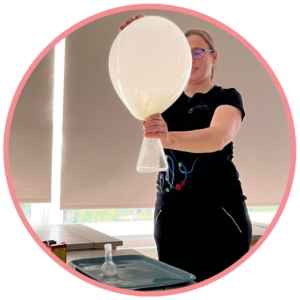“An effective educational tool that has long-term benefits and helps students connect what they learn with their everyday life. In our town, there’s also a wind turbine, so the tool really sparked the students’ interest.”
Marietta Lõo, teacher

The interest in the STEAM project ‘Wind Phone Charger’ led Antsla students, under the supervision of physics teacher Marietta Lõo, to experience active study outdoors. Taking on the roles of wind experts and engineers, they explored the wind and its properties outside. In teams, they tried to harness energy from wind in order to charge a phone. The project made outdoor learning an engaging part of the curriculum, sparked students’ interest in renewable energy, and developed interdisciplinary skills.
Challenge for outdoor learning
Marietta has occasionally practised outdoor learning, having mostly good experiences with it. Her desire is to teach outdoors more frequently and purposefully. Constraints are typically the lack of time for lesson preparation, and to some extent, the uncertainty of how to engage students with no prior project-based learning experience.
Testing Huvi experimental toolset and teaching materials
For the teacher, the majority of the preparatory work for the project is already done in the form of a teacher guide. Marietta conducted the lessons according to the Huvi guidelines and chose not to adapt or expand the given tasks this time. However, she led the prescribed activities and tasks purposefully, generating new ideas and thoughts on how to engage students actively in future lessons. The challenge this time was also the weather, as the day designated for testing the wind turbines was very calm, so the turbines were started by running through the school corridor. Nevertheless, the wind turbines worked as needed also this way. For a more detailed account, read teacher Marietta Lõo’s blog.
“In this particular STEAM project, I liked the research and exploration step the most. Students could experiment with various parameters affecting the rotation speed of the wind turbine, create graphs based on collected data, and analyse them. This gave me ideas on how to plan and make subject lessons more practical in the future. We need to practise more graph analysis; it’s a weak point.”
Marietta Lõo, teacher
Students learned about green energy using a wind turbine model and participated in the design process. Their challenge was to design blades for the rotor that would make the wind turbine work effectively and charge a phone. Working together with their team, they completed following steps:
- Formulating hypotheses, checking their accuracy, and seeking solutions.
- Collecting data with an anemometer in order to systematise and analyse it.
- Experimenting with the wind turbine blades included in the kit.
- Designing new blades for their wind turbine using a glue gun, wooden sticks, and cardboard.
- Measuring the rotation speed of the wind turbine with a smartphone.
- Presenting their results both orally and in written form.
“In this project, you need to use logical thinking and recall what you’ve learned before. The entire project allows you to do something on your own and develop your skills. Collaboration and seeking help when you’re stuck are very important.”
Antsla High School’s 8th-grade student
Interdisciplinary integration through project-based learning guided students to explore topics in physics, technology, art, and mathematics. Through teamwork, general competencies were developed, with time management, collaboration, delegation, and decision-making being the most important aspects.



